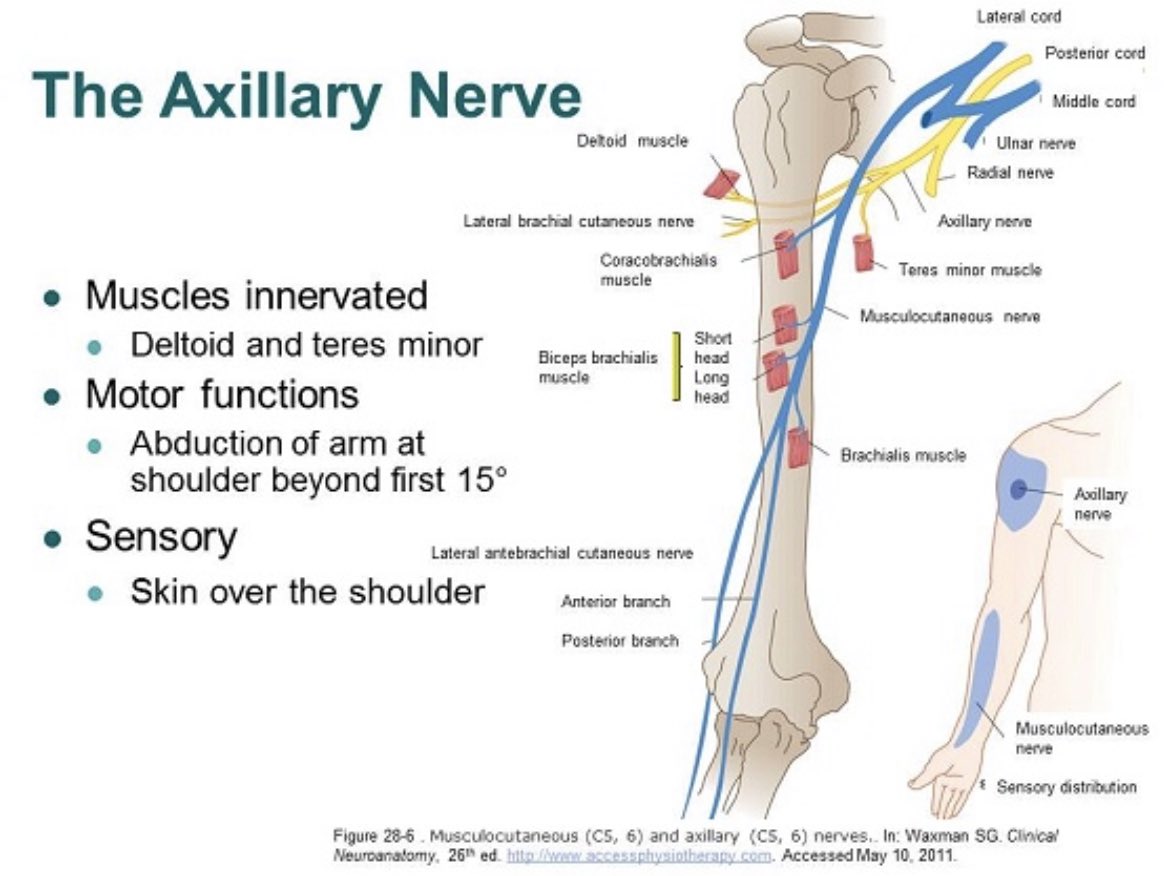Related Subjects:
|Radial Nerve
|Median Nerve
|Ulnar Nerve
|Musculocutaneous nerve
|Axillary nerve
|Brachial plexus
|Dermatomes
The axillary nerve is a major peripheral nerve of the upper limb, arising from the brachial plexus. It is responsible for innervating the deltoid and teres minor muscles and providing sensory information from the skin over the deltoid.
Anatomy of the Axillary Nerve
- Origin :
- Arises from the posterior cord of the brachial plexus.
- Composed of nerve fibers from the C5 and C6 spinal nerves.
- Course :
- Exits the axilla posteriorly through the quadrangular space, bordered by the teres minor, teres major, long head of the triceps brachii, and the surgical neck of the humerus.
- Divides into anterior and posterior branches.
Branches of the Axillary Nerve
- Anterior Branch :
- Innervates the anterior and middle portions of the deltoid muscle.
- Provides sensory innervation to the skin over the lower part of the deltoid.
- Posterior Branch :
- Innervates the posterior portion of the deltoid muscle and the teres minor muscle.
- Gives off the upper lateral cutaneous nerve of the arm, providing sensory innervation to the skin over the lower part of the deltoid.
Functions of the Axillary Nerve
- Motor Functions :
- Deltoid Muscle: Abducts the arm at the shoulder.
- Teres Minor Muscle: Externally rotates the arm at the shoulder.
- Sensory Functions :
- Provides sensation to the skin over the lower part of the deltoid muscle (the "regimental badge" area).
Clinical Relevance
- Axillary Nerve Injury :
- Commonly occurs due to shoulder dislocation or fractures of the proximal humerus.
- Symptoms include weakness in shoulder abduction, loss of sensation over the deltoid, and atrophy of the deltoid muscle.
- Quadrilateral Space Syndrome :
- Compression of the axillary nerve within the quadrilateral space.
- Symptoms include vague shoulder pain, weakness in shoulder abduction and external rotation, and sensory disturbances over the deltoid.
- Evaluation :
- Clinical examination includes testing shoulder abduction and external rotation strength.
- Sensory testing over the deltoid region.
- Imaging studies, such as MRI or ultrasound, may be used to assess nerve compression or injury.
- Electromyography (EMG) and nerve conduction studies can evaluate the functional status of the nerve.
Management
- Conservative Treatment :
- Physical therapy to maintain shoulder mobility and strength.
- Analgesics and anti-inflammatory medications for pain management.
- Activity modification to avoid further injury.
- Surgical Treatment :
- Indicated in cases of severe nerve injury, persistent symptoms, or compression syndromes.
- Procedures may include nerve decompression, neurolysis, or repair.
Summary
The axillary nerve, originating from the posterior cord of the brachial plexus, innervates the deltoid and teres minor muscles and provides sensory input from the skin over the deltoid. It plays a crucial role in shoulder abduction and external rotation. Injuries to the axillary nerve, such as those resulting from shoulder dislocation or fractures, can lead to significant functional impairments and require careful evaluation and management.
